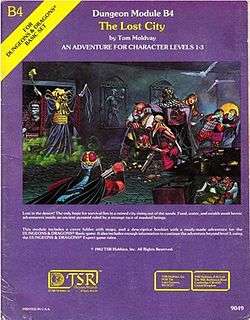The Lost City (Dungeons & Dragons)
 | |
| Code | B4 |
|---|---|
| TSR Product Code | 9049 |
| Rules required | Dungeons & Dragons |
| Character levels | 1–3 |
| Campaign setting | Mystara |
| Authors | Tom Moldvay |
| First published | 1982 |
| Linked modules | |
| B1, B2, B3, B4, B5, B6, B7, B8, B9, B1-9, B10, B11, B12, BSOLO | |
The Lost City (B4) is a Dungeons & Dragons adventure module by Tom Moldvay.[1] It was first published by TSR in 1982 and was designed as a stand-alone adventure for use with the Dungeons & Dragons Basic Set. The working title for the module was "The Lost City of Cynidecia".[2] Moldvay designed the module to give novice Dungeon Masters experience fleshing out adventures and is only partially complete. The module is described as a low-level scenario, in which the only hope of the player characters' survival can be found in a ruined city slowly rising out of the sands.[3] The adventure is set inside a huge step pyramid, with the lower pyramid only sketched out and the city itself described with a list of the major areas and a map. The adventure’s main villain is Zargon, a giant one-eyed monster and his minions. The entire double pyramid, not including the city, contains over 100 rooms.
This module includes a cover folder with maps and a descriptive booklet with ready-made adventurers for the Dungeons & Dragons Basic Game. It also includes enough information to continue the adventure beyond level 3, using the Dungeons & Dragons Expert Game rules. This adventure was partially reprinted in the supermodule compilation B1-9 In Search of Adventure (1985), which included only the upper pyramid and was set in the Mystara campaign setting.
Plot summary
The adventure follows a city buried in the desert, which is torn between warring factions.[1] Much of the adventure takes place within a huge step pyramid.[1] Other areas of the city are merely outlined, with suggestions provided for the DM to provide detail.[1]
At the beginning of the adventure, the characters become lost in a desert sandstorm and stumble upon the entrance to a pyramid. The pyramid and the underground city beneath it are located on the site of the ancient ruined city of Cynidicea and inhabited by the descendants of the city's people. These Cynidiceans, now regressed to a subterranean species, are addicted to narcotics and spend most of their time in drug-induced reveries, wandering around in costumes and masks.
As the adventure progresses, the characters discover that a monster known as Zargon was responsible for the downfall of Cynidicea. The monster still lives, and a cult of evil human priests and various other monsters has grown up around it. Besides the priests of Zargon, there also exist three other factions of relatively normal Cynidiceans. They worship the city's ancient Gods and are dedicated to the overthrow of the priests of Zargon and the restoration of Cynidicea's lost glory, but their diverging faiths have disallowed them from working together against their common enemy.
Although only the upper half of the pyramid is detailed, enough information on the lower half and the underground city is provided for the DM to expand the adventure. After clearing the upper pyramid the players can become involved in the struggle for Cynidicea and, if they grow powerful enough, confront Zargon in his lair and destroy him.
Publication history
The Lost City was written by Tom Moldvay and illustrated by Jim Holloway. It was published by TSR in 1982 as a 32-page book with an outer folder; the first printing was 3-hole punched.[1]
Dragon magazine revisited the setting with "Mystara: Return to the Lost City" in issue #315.
The module was the inspiration for a 3rd edition D&D adventure, "Masque of Dreams," which was printed in Dungeon #142. The adventure was written by B. Matthew Conklin and illustrated by Michael William Kaluta.[4]
Zargon and the Cynidiceans received a re-interpretation in the 3.5 edition product, Elder Evils, which places the temple in the default, Greyhawk-like setting.
Reception
The Lost City was ranked the 28th greatest adventure of all time by Dungeon magazine for the 30th anniversary of the Dungeons & Dragons game in 2004.[5]
Ken Denmead of Wired included the module as an installment in his column "Top 10 D&D Modules I Found in Storage This Weekend".[6] According to Denmead, "with this module, things are clearly detailed to a certain point, and then the rest is left for the DM to "Expand the Adventure," including a final confrontation with the evil "God" who helped bring down the civilization, and eventual discovery of the remnants of the people living a strange, drug-addled life of mushroom farming beside a subterranean lake."[6]
Additional reading
Review: Different Worlds #28 (1983)
References
- 1 2 3 4 5 Schick, Lawrence (1991). Heroic Worlds: A History and Guide to Role-Playing Games. Prometheus Books. p. 135. ISBN 0-87975-653-5.
- ↑ Basic Series. Acaeum. Retrieved 14 December 2008.
- ↑ Livingstone, Ian (1982). Dicing with Dragons, An Introduction to Role-Playing Games (Revised ed.). Routledge. ISBN 0-7100-9466-3. (preview)
- ↑ Conklin III, B. Matthew (January 2007). "Masque of Dreams". Dungeon (magazine). Wizards of the Coast (142): 14–30. ISSN 0890-7102.
- ↑ Mona, Erik; Jacobs, James; Dungeon Design Panel (November 2004). "The 30 Greatest D&D Adventures of All Time". Dungeon. Paizo Publishing (116): pp. 68–81.
- 1 2 Denmead, Ken (December 27, 2007). "Top 10 D&D Modules I Found in Storage This Weekend". Wired. Archived from the original on August 20, 2009. Retrieved August 12, 2009.
External links
- The Lost City at the TSR Archive
- http://www.rpg.net/news+reviews/reviews/rev_4114.html